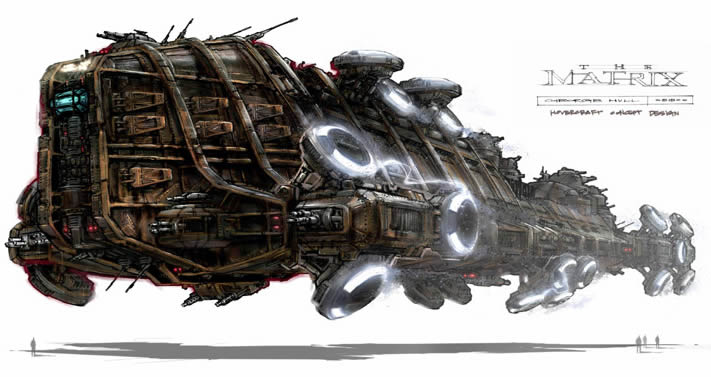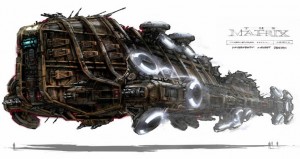
 Archival interview with Marc Gabbana from the official Matrix website.
Archival interview with Marc Gabbana from the official Matrix website.
MATRIX: What other projects have you worked on?
MARC: I just wrapped up being concept artist on Star Wars Episode 2 a couple of weeks before I started on this show, and basically only had two weeks off then got right back in the thick of it again on this project.
MATRIX: How has the transition been?
MARC: I know there is kind of a clan war fare between the two camps, between THE MATRIX and Star Wars, so I feel very fortunate to be part of both, and not letting one influence the other. They are two separate projects, but they are both just as big as each other; they’re both as much fun.
MATRIX: In the Directors’ ways of working, do you see a distinction between the two?
MARC: When I worked on Star Wars I was working on it from my house in Canada, so I didn’t have any contact with George Lucas at the time. The only person I had contact with was the Design Director, Doug Chiang, who would simply brief me on the phone and then I would talk to him, fax him and email him drawings. Here it’s the total opposite, the brothers [Larry & Andy Wachowski] are in house and they come right in our cubicle here, or pod, and are very, very specific about what they want, which is actually very cool. The neatest thing is they both know exactly at the same time what each other is thinking and what each other wants, so there really are not two different directors on this, there’s always one singular vision, which really, really helps us. And Owen [Paterson, Production Designer] is there and we all work great as a team together.
MATRIX: You are one of many in this team; what is the process of creation?
MARC: The very first thing I worked on was a large overview of the Zion Dock where they had a dozen space ships landed. Geof Darrow designed it in his drawings, and Rpin [Suwannath] modeled in the computer. The brothers picked an angle from the computer generated model and they printed a scene for me to paint from, so I actually painted right on the print-out of the scene showing all the myriad of details: the lighting effects and the color, so everything is very, very accurate.
That is going to help the model makers as far as the kind of level they want to achieve in there, and it’s going to help the Art Directors as far as knowing how much of a set to build, because this set is about a mile across. The Art Directors were here, Hugh [Bateup] and Mark [Mansbridge], and I overheard them say, “Well, we can only build this little part right here, which is pretty much a set, 100 by 200 feet perhaps, and the rest will be all digital, matte painting or digital effects.”
MATRIX: With the direction being very specific, do you find it more liberating or more difficult to express what they want? Do you feel you have more or less freedom?
MARC: I don’t know if freedom is the right word. We are hired specifically to bring the Directors’ vision to the screen; the more they can tell us, the more specific we can be. We’re not really wasting time on twenty different versions of what they’re looking for, they’re so specific. Our time is at a premium on this show, and I think that’s why we can afford to work on these paintings a lot tighter than any other shows I’ve worked on, and really define the mood and the whole look of it. It is liberating in the sense that there really is no guess work as to which way we’re going to go.
The fun part is in the details too. The brothers are great at giving feed back, even if they want some minor adjustments, I just whip out the paint and do it right in front of them, just to get some initial feedback, then a couple of hours later I’ll show them the final result. Decisions are made very, very quickly here, I don’t think we spend more than a few days per drawing. The main exception was the big Zion Dock, which I spent three weeks painting, just because there was so much detail and so much information needed to be in there accurately.
MATRIX: Detail seems to be quite an important facet of this production.
MARC: Definitely. The very first thing I did here, before the Zion Dock, was the Keymaker’s Cell. It’s a very small cell, maybe 20 feet across with an arched dome ceiling and he’s basically a prisoner in there. He’s in front of his key making machine making keys, all around him are thousands and thousands of keys, and he lives in this room. That was my first project, a very claustrophobic environment, very dark, very intimidating.
MATRIX: Have you had the opportunity to read THE MATRIX 2 and 3 scripts?
MARC: I’ve read number two, I haven’t had a chance to read number three yet.
MATRIX: Larry and Andy give you all the direction, but you are the person who is actually putting their ideas on paper, how does it feel to be creating something you have read; to be the person putting the look to the words?
MARC: It’s actually my job, this is what I wanted to do and they’re paying us to do this. This is a great opportunity, there’s really no second-guessing ourselves, we’re all professionals here, this is something that we aspired to do a long, long time ago, and all of a sudden this dream project comes along. It’s great that they put that much trust in us, as much as we put into them: we’re looking towards them for direction, but they’re looking towards us to realize their vision as closely as possible on paper. Working with all the other artists has been great here because it seems that everybody is on the same wave length, everybody is on the same boat. All the work has a very, very consistent look to it, and of course that’s thanks to Larry and Andy.
MATRIX: What mediums do you work with to create your illustrations?
MARC: Most of the paintings I do are done in cell vinyl which is a type of acrylic, it’s actually animation paint that dries flat and allows you to work very quickly for really realistic looking paintings. The other style I use is magic markers where you would do a line work drawing. You would start with your line work, then you would simply apply markers to them and then just tighten them up with a little bit of paint; this is a much quicker method as the line work still shows up.
When you work with paint you have to cover every single black holding line and hold your edges with different values, marker is typically a lot faster. It probably takes three quarters of a day to do a painting like this with marker, versus two full days to do something that is much, much tighter and more final in paint. I’m using markers mostly for speed at this point, because I know our time is short on this project, and we still have tons and tons of work to generate.
These are basically the two mediums, everything starts with small little rough thumbnails and I get Owen to approve them, sometimes he gets the Directors’ okay, sometimes he just says go ahead, that’s fine. The chain of command and the decisions that are made to go ahead with a painting or a drawing are very, very quick, which is great, there’s no second-guessing at all here.
MATRIX: Are you used to putting this level of detail into your paintings?
MARC: Yes I am. In fact, working with markers is fine, but I really prefer to set the mood as much as possible because there’s much more control available with the paint on there. The hardest thing on the Dock was once it was half done, I knew I pretty much had to duplicate the other half, and I couldn’t flop it like in Photoshop because it is not exactly a mirror image. But it was a very fun painting to work on, it’s one of the biggies on the show here.
As far as some of the other drawings go, things begin as rough little thumb nails, exploring the various angles for the Directors to pick up on. Eventually I would go to a drawing which would show the Keymaker in his little cell and then do a drawing that is much tighter. The original was very moody, these kinds of colors right here, he looked pretty sad and lonely in there. His room is very cramped, I think this is the room that Neo comes in and takes him away. I also did a reverse angle of this same room, where you’re looking at his bed in the front, there are boxes filled with keys and Neo is going to appear through the back door. It is very claustrophobic and there are little shafts of light with the criss-cross shadow pattern all over the place, just to suggest the prison motif.
For every drawing, the brothers were pretty specific about what they wanted, but I still had a lot of freedom as far as what sort of a room to design. I think they’re definitely looking towards us for surprises, that’s the nice thing about a collaboration like this, because even though they have the words on paper and the images in their head, they still need us to interpret what they want. It’s the world’s best job.
MATRIX: Thanks Marc.
Interview by REDPILL
November 2000

Be the first to comment